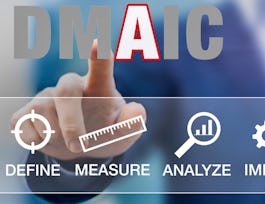The course will teach you the competencies and essential skills required to pass the American Society for Quality (ASQ) Certified Six Sigma Green Belt (CSSGB) exam. This course focuses specifically on the last three phases of the define, measure, analyze, improve, and control (DMAIC) framework and will enable you to analyze the root causes of existing issues, implement solutions, and ensure the process's sustainability. You will gain insight into data analysis techniques such as hypothesis testing and regression analysis and be able to develop control plans for process improvement.



The DMAIC Framework: Analyze, Improve, and Control Phase
This course is part of ASQ-Certified Six Sigma Green Belt (CSSGB) Exam Prep Specialization


Instructors: Jaswant Singh Verma
Sponsored by Mojatu Foundation
Recommended experience
What you'll learn
Describe the importance of analyzing data and identifying root causes of problems in the process.
Apply data analysis techniques such as hypothesis testing, regression analysis, and correlation analysis to identify the issues in your process.
Develop control plans and strategies for sustaining process improvements.
Use control charts and statistical process control techniques to monitor process performance.
Details to know

Add to your LinkedIn profile
11 assignments
See how employees at top companies are mastering in-demand skills

Build your subject-matter expertise
- Learn new concepts from industry experts
- Gain a foundational understanding of a subject or tool
- Develop job-relevant skills with hands-on projects
- Earn a shareable career certificate


Earn a career certificate
Add this credential to your LinkedIn profile, resume, or CV
Share it on social media and in your performance review

There are 5 modules in this course
In this module, you will learn why exploratory data analysis (EDA) is a critical component of data analysis in various domains, including statistics, data science, and machine learning. It involves examining and visualizing the characteristics of a dataset to gain insights, discover patterns, and identify relationships between variables. It also helps understand the data, identify quality issues, and formulate hypotheses for further analysis. Additionally, you will learn the fundamentals of correlation and linear regression and how to analyze and extract meaningful insights from datasets. This helps to strengthen the foundation for subsequent data analysis and modeling tasks, enabling informed decision-making and hypothesis generation.
What's included
6 videos2 readings3 assignments1 discussion prompt
In this module, you will learn about hypothesis testing, which is an important component of statistical analysis and data-driven decision-making. You will also learn how to apply hypothesis-testing techniques to infer population parameters based on sample data. Additionally, you will formulate hypotheses, select appropriate tests, conduct hypothesis tests, interpret results, and effectively communicate the findings. Hypothesis testing provides a systematic framework for making data-driven decisions and drawing valid conclusions based on statistical evidence.
What's included
5 videos1 reading3 assignments1 discussion prompt
In this module, you will learn about the design of experiments (DOE), which plays a crucial role in the improve phase of the Six Sigma methodology. It provides a structured approach for data-driven decision-making and process optimization and enables you to examine the parameter space efficiently to comprehend the relationships between factors and responses. You will also gain insight into designing and conducting efficient experiments, analyzing experimental data, and optimizing process variables. By applying DOE techniques, you can systematically assess the process space, identify influential factors, and optimize process performance while minimizing time, cost, and resources. The module also provides an overview of control charts, their uses, and applications in the Six Sigma methodology. Additionally, you will gain an understanding of various types of control chart patterns used to detect special causes of variation.
What's included
8 videos2 readings3 assignments1 discussion prompt
In this module, you will learn about strategies and practices to ensure that the improvements implemented in a process are sustained over the long term. You will learn how to establish a culture of continuous improvement, maintain process stability, monitor performance, and engage stakeholders in sustaining improvements. By mastering these strategies and techniques, you can ensure that the improvements implemented in a process have long-lasting effects and contribute to the organization’s overall success.
What's included
4 videos1 reading2 assignments1 discussion prompt
This is a peer-review assignment based on the concepts taught in The DMAIC Framework: Analyze, Improve, and Control Phase course. In this assignment, you will be able to explain how to apply the analyze, improve, and control phases of the DMAIC framework in a real-life scenario.
What's included
1 video2 readings1 peer review
Instructors


Offered by
Why people choose Coursera for their career




Recommended if you're interested in Data Science

Kennesaw State University

SkillUp EdTech

Kennesaw State University

Open new doors with Coursera Plus
Unlimited access to 10,000+ world-class courses, hands-on projects, and job-ready certificate programs - all included in your subscription
Advance your career with an online degree
Earn a degree from world-class universities - 100% online
Join over 3,400 global companies that choose Coursera for Business
Upskill your employees to excel in the digital economy



